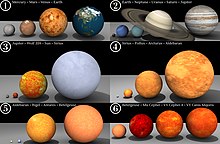Due to their great distance from the Earth, all stars except the Sun appear to the human eye as shining points in the night sky that twinkle because of the effect of the Earth's atmosphere. The Sun is also a star, but it is close enough to the Earth to appear as a disk instead, and to provide daylight. Other than the Sun, the star with the largest apparent size is R Doradus, with an angular diameter of only 0.057 arcseconds.[82]
The disks of most stars are much too small in angular size to be observed with current ground-based optical telescopes, and so interferometer telescopes are required in order to produce images of these objects. Another technique for measuring the angular size of stars is through occultation. By precisely measuring the drop in brightness of a star as it is occulted by

the Moon (or the rise in brightness when it reappears), the star's angular diameter can be computed.[83]
Stars range in size from neutron stars, which vary anywhere from 20 to 40 km in diameter, to supergiants like Betelgeuse in the Orion constellation, which has a diameter approximately 650 times larger than the Sun—about 0.9 billion kilometres. However, Betelgeuse has a much lower density than the Sun.[84]



0 comments:
Post a Comment